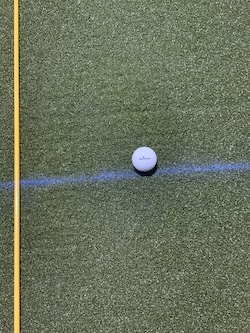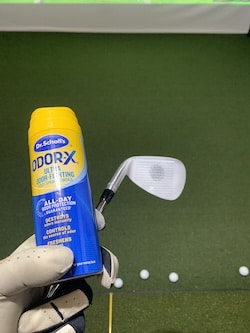There are plenty of options to practice golf at home, no matter what your setup looks like. I have practiced at home for years, starting with nothing more than the clubs I already had, to installing a simulator. Whether it is the middle of the winter, a rainy weekend, scorching hot, or you’re on a conference call, there’s always something you can be doing.
No matter what your current setup looks like, there’s something for everyone on this list to help you improve your game!
[Quick Nav]
Putting Drills to Practice at Home
Putting stroke and speed control are the primary areas you can target with your at-home putting practice. Using real golf balls on a putting mat, or even a section of low-pile carpet is something every golfer can do at home.
“Don’t hit my baseboards!” is a phrase I heard a lot when I was a kid practicing my putting in Grandma’s kitchen. Old brown tile-looking carpet, the hole cut from the thin cardboard of a cereal box set 6 inches from the wall. To this day, I am a “die it in” kinda putter. 😄
[Putting Quick Nav]
The Quarter Drill (Coin Drill)
Focusing on developing a smooth putting stroke, the quarter drill will give you instant feedback if you get too “jerky”. Simply place a quarter, or any coin for that matter, on your putter and try to make a full stroke without it falling off. If you hit a ball the coin is probably going to fall off at impact, but that’s fine. The objective is it keep it in place throughout the rest of the stroke.
If you have a blade putter, you may need to place the coin on the lower edge, you know, the section you use to pick up a ball after your buddy gives you the putt.
Do this with perfection for 3 sets of 10 reps each, taking a 2-minute break in between. Then move on to the Gate Drill.
The Gate Drill
Focusing on a smooth stroke and center-face impact. Yes, impact location with a putter is just as important as with any other club! There are two variations of this drill, depending on your putting stroke.
Arc Putting Stroke – Your “gate” should be at the impact point only. You can place two tees, one at the toe and the other at the heel, creating just enough of an opening for your putter to fit through. Set the tees upside down so they stand in place! Arc putting strokes are typical for those using blade putters.
Straight Through Stroke – Your “gate” can be much longer. Using two books, or two sleeves of balls, create a “runway” for your putter to go back and forth through. A straight-back straight-through putting stroke is more common for those using mallet putters.
The objective here is to get your putter through the hitting area without hitting the obstacles, focusing on a smooth stroke on the proper swing path.
Do this with perfection for 3 sets of 10 reps each, taking a 2-minute break in between. Then move on to the yardstick drill.
Yardstick Drill
Get a yardstick, or ruler, and set the ball on one end. The objective is to putt the ball on the line, working on your start line. You can also use the line from a putting mat if you have one, or even on a piece of carpet if a straight line is part of the design.
Do this with perfection for 3 sets of 10 reps each, taking a 2-minute break in between. Then move on to speed control drills.
Speed Control Drills
Set up a hole and a piece of 8×10 paper behind the hole. For the hole, just use a flat cutout from a thin cardboard box, or a plastic lid from a Pringles can. Your objective is to get the ball to stop anywhere between the front of the hole or on the paper. You can use anything for this, just give yourself a 1-foot window to hit into.
Do this with perfection for 3 sets of 10 reps each, taking a 2-minute break in between. Then move on to the Aim Small drill.
Aim Small
Aim small, miss small. Cut out a hole that is about half the size of a regular hole. You could even set a ball up and just try to hit the ball with your putt. Varying distances are ideal, your goal is to be perfect from 6 feet.
You can incorporate all of these putting drills at the same time, or a combination of any. If you do, be sure to complete them separately from time to time as it will ensure you are focused on one specific task and help you develop a solid putting stroke.
Related – Wellputt mat & Wellstroke review
Practicing Chipping and Wedge Play
You can either use practice golf balls, or a real golf ball, depending on your confidence level and risk tolerance for breaking something in your space. If you have a net and practice mat, great. If not, there are plenty of options.
Without a net, you can set up on the carpet and hit into a sofa. You can add a blanket in your landing area for extra protection.
Your goals here will be to work on turf interaction, trajectory, and distance control. Set a golf towel in your landing area, or anything about that size. Spend time trying to land your ball on the towel. Varying distances are ideal.
For added difficulty, you can attempt to chip a coin. To do so effectively, your turf interaction will need to be near perfection.
If you have a yard, you can get creative and set up obstacles and challenges for yourself there, but understand you may end up with some bare spots.
Full Swing Work
If you have the space to take a full swing, great. Even if you can only hit practice balls, there are plenty of things you can work on! Its also important to ensure you have proper alignment during practice, very easy to do with an alignment rod.
[Full Swing Quick Nav]
Little Ball Before Big Ball
Ball first contact is something you can focus on and check easily. There are a couple of options to check this as you’re hitting balls. These can be done with both real or practice balls.

You can snap a chalk line on your mat, then place the ball on the front edge of it. Hitting behind the ball makes the line go away pretty quickly.
You could also use a piece of tape. Something like painter’s tape will work. Just set your ball up on the front edge of the tape and don’t hit it fat!
A towel works great too! Simply lay a towel flat, something pretty thin is ideal, and put the ball just in front of it. You’ll know right away if you’ve hit behind the ball.
Related – Find out if hitting off mats can hurt your golf game
Gate Drill
Just like the gate drill for putting, you can set up a small window to hit through using a couple of tees. Give yourself about a 1/2 inch on each side of the club (heel/toe) and the tee on the heel should be tilted so your shaft doesn’t clip it on the way through. Put a ball in the middle and hit away!
The objective here is to help you hit the center of the club face. The more narrow you can make it, the better.
Impact Location

When practicing golf at the driving range or home, it’s always great feedback to check your impact location.
I like to use foot powder spray, it only takes a few seconds to apply and wipes off easily when you’re done.
You can also use impact tape. The smaller the shot group the better. You’ll get immediate feedback and give yourself the ability to make adjustments as needed.
Start Line Drill
If you have a net or a screen to hit into, you can make a vertical line directly in front of your ball to get feedback on your start line. If you’re using a net, you can tie a 3-foot piece of white string. As you hit shots into the net, you’ll be able to see which side of the string you hit.
You can also work on hitting fades/draws with this approach. Let’s say you are a right-handed golfer and you want to work on hitting fades. Your ball should hit on the left side of your line, and then spin to the left as it bounces off the net and lands on the ground. The ball will spin back in the opposite direction it was spinning when it left the club face.
Swing Speed Training
If you are someone who cares about game improvement enough that you are practicing golf at home, swing speed training is something you should consider. There are plenty of speed training options available to help you increase your clubhead speed. Whether you simply use what you currently have, or you go with a training aid, adding speed to your golf game can drastically improve your scores.
Mirror or Video
Have you ever taken a video of your golf swing? If not, I can assure you, for 99% of golfers it is an eye-opening experience. What you think you look like and what you actually look like in the golf swing are usually vastly different. You can pick up a cheap tripod from Amazon and record some front and down-the-line views. Set the camera height to waist-high and be sure to have it set far enough away that you get the full swing.
Slow motion works best! You can also observe much of your swing with a mirror. Go through the motions of your swing, pausing at various points, and take a look at yourself. You’ll get some valuable feedback.
Practice The Mental Game at Home
It may sound crazy, but some of the best rounds of golf I’ve ever played came after I visualized the entire round before actually playing. Visualization and meditation are some incredibly powerful tools, not only for golfers, but all athletes and even in your daily life.
How can a golfer meditate and improve their game? Long story short, when you perform a repetition in your mind, it has a fair bit of equivalency to a real physical repetition. So if you are practicing golf shots perfectly in your mind, it’s the next best thing to hitting a perfect shot on the course or at the range.
Here are more tips for the mental game!
Training Aids and Equipment
I am not a huge fan of most training aids, there are plenty of gimmicks out there. But, there are some that I would feel comfortable recommending to help you practice golf at home, including the prosendr
If you have a sim setup, dial-in your distances from 100 yards and in. Do practice sessions where it is boxed, meaning you hit the same distance over and over. Say 20 shots at 50 yards, then 20 shots at 75 yards. Then incorporate random distance sessions, meaning you choose random distances between 100 yards and in, hitting one shot each.
Final Thoughts
Practicing golf at home does not require a putting green or a golf simulator. There is plenty you can work on, especially putting and chipping, with nothing more than what you already have.
Regardless of your setup, consider taking videos or practicing in front of a mirror. It will give you some valuable insights. And don’t overlook the mental game! Simply taking time to visualize a perfect round of golf can go a long way!
Good luck on the golf course!
